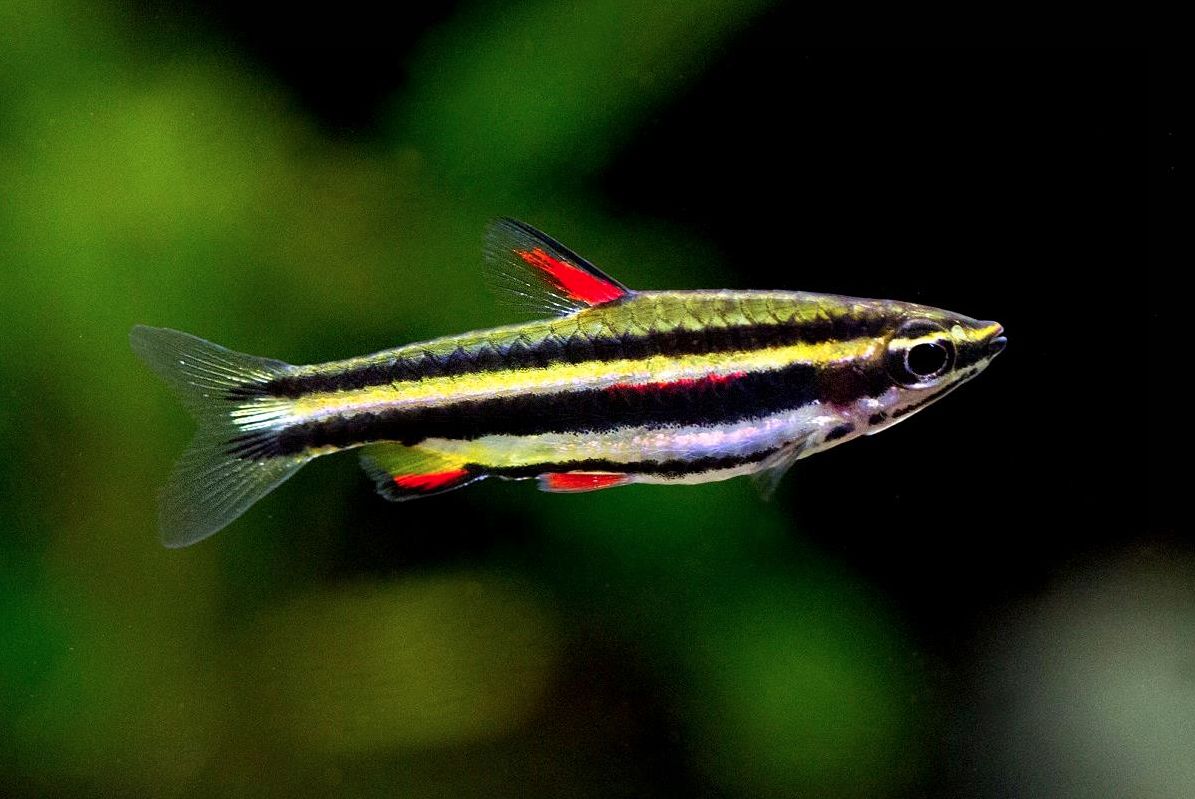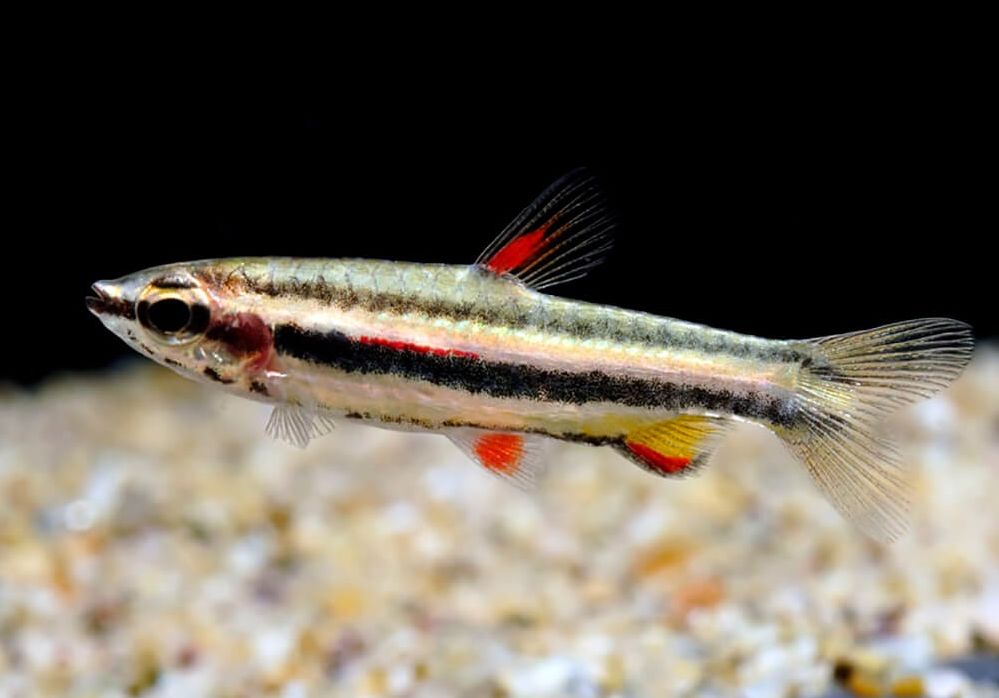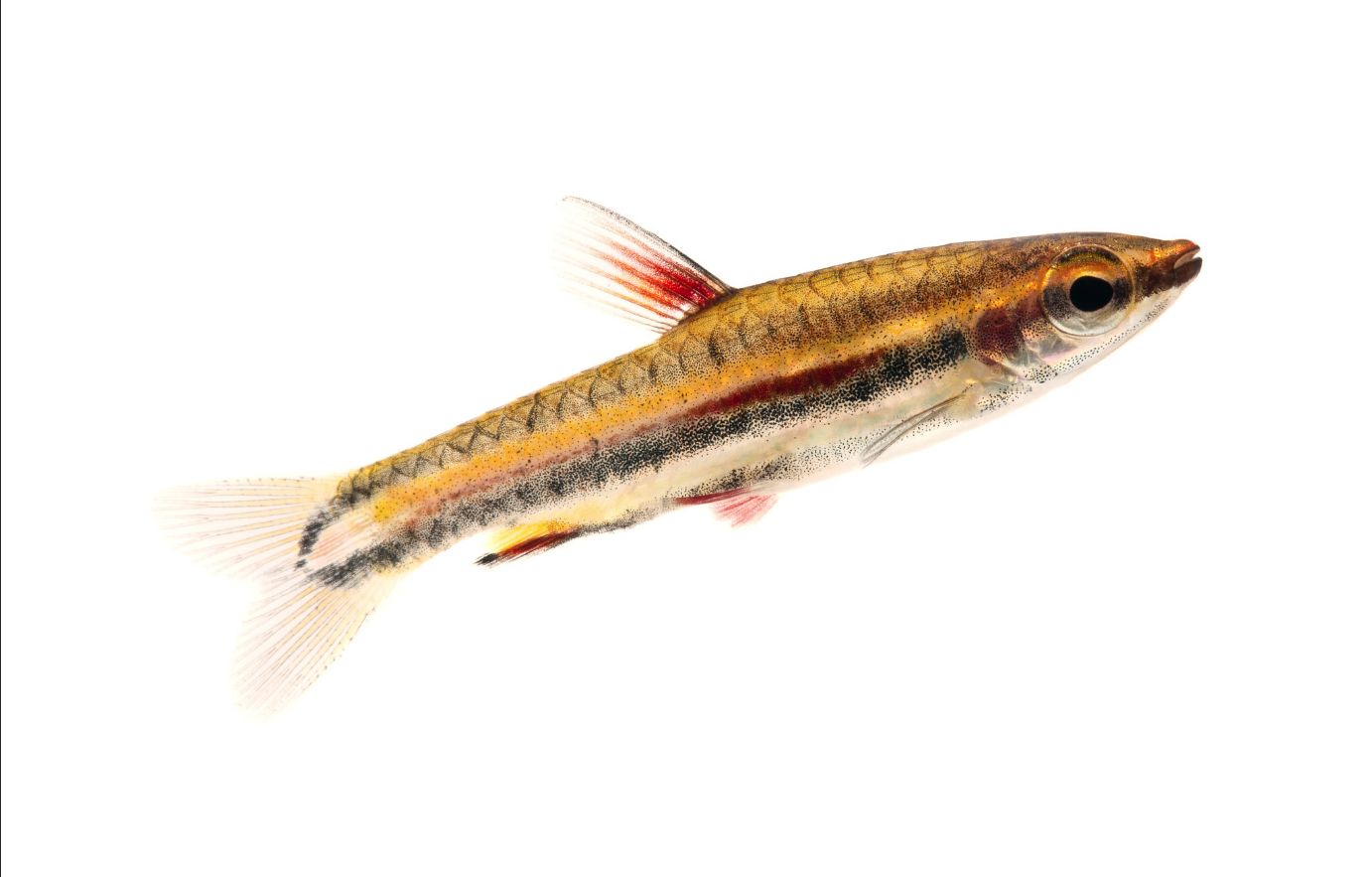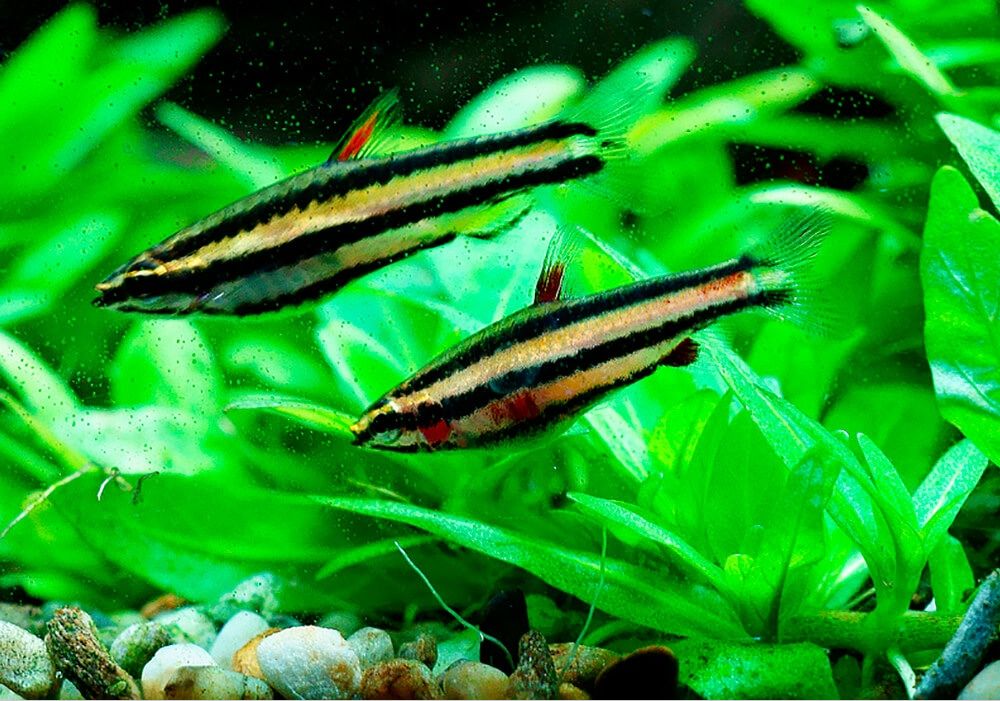Dwarf pencilfish (Nannostomus marginatus) is a charming freshwater aquarium fish and one of the smallest members of the Lebiasinidae family within the Characiformes order. Known for their vibrant colors and peaceful nature, they make a delightful addition to aquariums, especially nano setups, which are becoming increasingly popular.
Despite their appeal, dwarf pencilfish face breeding challenges and lay a limited number of eggs, which contributes to their rarity in the aquarium trade. As a result, they are seldom seen in home aquariums, yet they thrive in well-planted tanks where they can display their natural behaviors.

Contents
Habitat in the wild
The dwarf pencilfish (Nannostomus marginatus) is a captivating freshwater fish belonging to the Lebiasinidae family, commonly known as the Pencilfish family. This family includes several species of small, slender-bodied fish native to South America, particularly in the Amazon and Orinoco River basins. Renowned for their peaceful demeanor, vibrant colors, and unique pencil-like shape, these fish are a delightful addition to many aquariums.
Notable relatives within the Lebiasinidae family include the golden pencilfish (Nannostomus beckfordi) and the red pencilfish (Nannostomus mortenthaleri). While each species has its own distinct characteristics and care needs, they share similarities in body shape, behavior, and habitat preferences.
Dwarf pencilfish were introduced to Europe in 1928, quickly earning the name “dwarf” due to their tiny size. They are primarily found in the Amazon Basin, particularly in the Suriname and Essequibo River basins, where they inhabit small rivers and streams. Their natural habitats are characterized by dense vegetation, submerged branches, tree roots, and leaf litter, resulting in dark, slightly acidic water enriched with tannins from decaying plant matter.
These shoaling fish thrive in groups, relying on their social structure for safety and interaction. Their small size allows them to navigate through intricate vegetation, where they seek shelter among submerged roots and floating plants to evade predators and find food.
In the wild, dwarf pencilfish primarily feed on small invertebrates, including insects, insect larvae, small crustaceans, and zooplankton. They are opportunistic feeders, also consuming plant matter and microorganisms present in their environment.
If you’re considering adding dwarf pencilfish to your aquarium, it’s important to replicate their natural habitat to ensure their well-being.
Description
The Nannostomus genus, derived from the Greek word “nanos” (small) and the Latin “stomus” (related to the mouth), includes about 15 species of slender, colorful fish, such as Beckford’s pencilfish. A distinctive feature of this genus is the notable absence of a fatty fin.
Among them, Nannostomus marginatus stands out as one of the smallest and most fascinating representatives. Dwarf pencilfish typically measure around 1 inch (2.5 cm) in length, though they can occasionally grow up to 1.5 inches (3.8 cm). Males tend to be slightly larger and more elongated than females. These compact dimensions make dwarf pencilfish ideal for smaller aquarium setups, where their shoaling behavior can be enjoyed even in limited spaces.
With an average lifespan of 3 to 5 years, regular monitoring of their health and prompt attention to any signs of illness can help maximize their longevity.
Dwarf pencilfish have a slim, spindle-shaped body, a small mouth, and prominent eyes. Their unpaired fins—except for the tail fin—are typically red with dark edges, while the transparent pectoral fins and grayish-tinted tail fin with rounded edges add to their charm. Notably, they lack a fatty fin.
An intriguing aspect of Nannostomus marginatus is their nocturnal coloration. In some species, this nighttime appearance can differ dramatically from their daytime hues, which may surprise an inexperienced observer. At night, the fish’s stripes become paler, and the central stripe transforms from a solid line into a dashed pattern. Interestingly, females may exhibit this nighttime coloration during the day if they are not yet ready to spawn, prompting males to be more patient until the females signal they are prepared.
| Characteristic | Description |
|---|---|
| Scientific Name | Nannostomus marginatus |
| Common Name | Dwarf Pencilfish, marginatus pencilfis |
| Family | Lebiasinidae |
| Origin | South America (Amazon Basin) |
| Size | Up to 1.5 inches (3.8 cm) |
| Lifespan | 3-5 years |
| Temperament | Peaceful, shoaling fish |
| Tank Size | 10 gallons (38 liters) or larger |
| Water Parameters | pH 6.0-7.0, temperature 75-82°F (24-28°C) |
| Tank Level | Middle to upper levels of the tank |
| Diet | Omnivorous, primarily small invertebrates and zooplankton in the wild. In captivity, they accept a variety of foods, including flakes, pellets, and live/frozen foods. |
| Compatibility | Peaceful community fish, best kept with other small, peaceful species |
| Behavior | Shoaling, active, and inquisitive |
| Sexual Dimorphism | Males are generally more colorful, with elongated dorsal and anal fins compared to females |
| Breeding | Egg scatterers, require soft and acidic water for successful breeding |
| Special Considerations | Prefer well-planted tanks with hiding spots and subdued lighting. Can be sensitive to water quality, so regular monitoring and maintenance are important. |

Difficulties in keeping
Dwarf pencilfish have won the hearts of aquarists from the very beginning, thanks to their vibrant coloring, peaceful temperament, tiny size, and relative ease of care and breeding. For fans of nano aquariums, finding suitable inhabitants can be a challenge, but representatives of the Nannostomus genus often emerge as top candidates. With most species averaging about 3 cm in size, even a small tank can comfortably accommodate a school of these charming fish.
While dwarf pencilfish are quite resistant to many illnesses, they are sensitive to abrupt changes in water parameters. Therefore, it’s crucial to avoid introducing newly purchased fish directly into a new tank. To ensure their health and well-being, it’s best to acclimate them gradually to the new conditions.

Care and keeping in a tank
Tank size
To keep a small school of dwarf pencilfish, a tank of about 10 gallons (38 liters) is the minimum recommended size. However, a larger volume, such as a 20-gallon (76 liters) tank or more, is preferable, especially if you plan to maintain a group of these social fish. Dwarf pencilfish thrive in schools and exhibit their most vibrant colors when kept in larger groups.
A more spacious tank not only enhances their visual appeal but also provides ample surface area for beneficial bacteria to establish, helping to maintain stable water parameters. With the right setup, these charming fish will not only flourish but also create a lively, dynamic environment in your aquarium.
Water parameters
Maintaining optimal water quality is crucial for the health and well-being of dwarf pencilfish. Filling your tank with tap water that is free from chlorine and heavy metals is sufficient. You can easily achieve this by using any available water conditioner; there’s no need to let the water sit after conditioning.
For the best results, aim for a tank temperature of around 23–26°C (73.4–78.8°F). The ideal pH range is between 4 and 7, with an optimal value around 6–6.8. Water hardness should be up to 15 dGH, with 8 dGH being ideal.
While wild dwarf pencilfish typically inhabit soft waters, they can adapt well to harder conditions in an aquarium. However, soft water is essential for the successful development of their eggs. By monitoring and adjusting these parameters, you can create a thriving environment for your dwarf pencilfish.
Tank setup: decorations and plants
A dark-colored substrate is ideal, complemented by moderate planting that provides both shelter and swimming space. In their natural habitats, dwarf pencilfish are often found in small groups near the shore among dense aquatic vegetation. Mimicking these conditions in your aquarium will help them thrive.
Opt for thin-leaved plants, which offer ample hiding spots while allowing free swimming areas. Dwarf pencilfish spend much of their time foraging among the plants and often feed near stones covered in algae. This natural behavior can be encouraged by maintaining a well-planted tank that resembles their native biotope.
Filtration
Dwarf pencilfish thrive in clean water, but their small size makes them sensitive to strong water flow. To maintain optimal conditions, canister filters are ideal, as you can adjust the flow to avoid disturbing the fish. For smaller tanks, an internal filter is a suitable alternative.
When choosing a filter, ensure it provides adequate filtration without creating a strong current. This will help maintain water quality while keeping the fish comfortable and stress-free.

Diet
Dwarf pencilfish are omnivorous and thrive on a varied diet that mimics their natural feeding habits. In the wild, they consume small invertebrates like insects, insect larvae, small crustaceans, and zooplankton. In captivity, they readily accept a range of foods, but it’s important to ensure that their diet is well-balanced.
Due to their small mouths, dwarf pencilfish prefer tiny crustaceans, such as cyclops and daphnia. They also enjoy small tubifex and bloodworms, whether live or frozen. However, relying solely on live or frozen foods may not fully meet their dietary needs and could lead to health issues.
A more suitable approach is to provide high-quality artificial foods that are rich in balanced nutrients. Look for formulas that contain essential vitamins and additives designed to enhance coloration, support the digestive system, and boost immunity.
Tank mates
In a tank, dwarf pencilfishes stay in a group in upper and middle water layers. They move like a small torpedo. When looking for food, they often scatter around the tank, but some time later, they gather together again.
The school should consist of at least 6 species. Males will compete with each other, but this can be avoided by thickly plating the tank. In a tank, there should be fewer males than females or at least equal numbers; otherwise, the females will always be stressed. The rivalry between males and sometimes females usually limits to opening their fins and spending some time swimming side by side.
Good tank mates for marginatus are any of the related species as well as small-sized carps and catfishes.
Dwarf pencilfishes are not aggressive and join any community of small fishes. Good tank mates for them are neon tetra, black neon tetra, bloodfin tetra, cardinal tetra, rummy nose tetra, serpae tetra, white cloud mountain minnow, cherry barb, ember tetra, endler’s guppy, glowlight tetra, harlequin rasbora, platy fish. And peaceful catfishes: bristlenose pleco, glass catfish, otocinclus catfish, adolfo’s catfish, panda cory, pygmy cory, corydoras julii.
Many other tropical freshwater aquarium fishes of proper size and tank conditions will do as dwarf pencilfishes tank mates. Large fishes may start preying on them. Of course, their small size may provoke large fishes to behave like this. Dwarf pencilfish may become prey of such fishes as angelfish, large-sized gourami (kissing gourami, giant gourami), and catfishes (pictus catfish, redtail catfish, striped raphael catfish, sun catfish).
Gender differences: male vs. female
Although the differences between males and females are subtle, they can be observed with careful attention.
Males are generally smaller than females and display more vibrant coloration. They have a slim abdomen and a rounded anal fin, which is a key distinguishing feature. In contrast, females possess a more transparent anal fin that lacks the rounded shape, making it difficult to identify without close examination. Observing males chasing females is a reliable way to confirm that a female is ready for breeding.
Additionally, females tend to have a more pronounced black lateral stripe along their bellies. Males may have a shorter or paler stripe, and in some cases, they might lack this stripe entirely. It’s important not to rely solely on this characteristic for sex determination, as there are exceptions; some females may have less visible stripes, while some males may display prominent ones.

Breeding
Reproductive dwarf pencilfishes spawn all year-round. Breeding the fish is in general similar to breeding other genus representatives.
Breeding dwarf pencilfishes is challenging since they lay very few eggs and eat them rather intensively. Potentially an adult female can lay hundreds of eggs in one spawning, but in real life, at the end of the spawning, there isn’t much left from the clutch. Therefore, you’ll have to take some measures to save it.
Usually, a plastic net is used for this purpose. If you don’t have it, you can cove the tank bottom with moss (java moss) or any other that you have.
A reliable way of saving the eggs hasn’t been found yet. Therefore we manage to get about 20-30 juveniles from one couple during one spawning. Getting 40-50 juveniles is a great result.
The fish can lay eggs even in small volumes. But the smaller square of the bottom. The fewer eggs will survive since the breeders actively search for them and eat them.
During 30 minutes the eggs stay sticky and if it didn’t fall through the net but stuck to it or any other surface, it has no chances to survive.
A large square of the tank bottom due to uniform scattering of eggs allows saving maximum of them. The water level in the spawning tank shouldn’t exceed 10 cm (4 in), which allows the eggs to fall under the net before they are eaten. Tank lighting should be dim and scattered.
For spawning, dwarf pencilfishes require very soft water: hardness — 1,5—2,5 dGH, pH 5,5—6,5, temperature 26—28 °C. It is preferable to acidify the water using peat extract.
A fish couple that tried to spawn in the common tank is better to be used for spawning. It’s not a problem to find such a couple for an experienced aquarist. If they started spawning in the community tank, they would likely continue it in the spawning tank.
Or you can use a female and two males. After they form a couple, one male is removed from the tank.
Before spawning, males and females should be kept separately for 14 days provided with a diversified diet. During this time, they should adapt to soft water (by pouring it into the volume with fish in small portions).
The breeders are put for spawning in the evening, and in the morning, they usually start to lay eggs. During the spawning, the excited male actively chases the female, but he doesn’t do any harm to her. The spawning may take several days.
The female lays tiny eggs. In the water, they swell and become significantly larger. After laying the egg, the female turns to eat it right away. Males do this as well, but less often.
For this reason, once the spawning is over, you should remove the breeders from the spawning tank, then the spawning substrate and the separating net.
Depending on the water temperature, the eggs incubation time is from 30 to 50 hours. In soft water, usually on the 3rd day, the larvae hatch. Since they are afraid of light, the spawning tank should be shadowed.
The fish larvae is a small transparent ball with a tail that for two days lay on the tank bottom. On the third day, they move on the tank walls.
Unlike other fishes larvae, they start getting their coloring even at this stage of development which makes them well visible for an observer. During this time, they have a large yolk sac, feeding on which they live during the next several days. After the yolk sac is over, the larvae turn into a juvenile.
Feeding the juveniles is easy. Since they are slow-moving, the amount of food in the tank should be sufficient. The juveniles feed during the whole day, eating something from tank walls and bottom. In 3-4 days, you can add brine shrimp nauplii into their diet. In the beginning, the juveniles grow rather slowly, but once they are 1.5 cm long, they start growing faster, especially after you put them into a larger volume. By the age of 2 months, the juveniles are usually 22-25 mm long.
At the age of 3 months, you can define their sex. The females are a bit larger, and the males’ anal fin is noticeably rounded. They behave as adult fish as well.
At the age of 5-6 months, Nannostomus marginatus becomes reproductive. You can define the moment by seeing that males and females start demonstrating mutual interest.